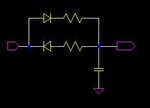kappa_am
Full Member level 6

Hi all,
I am designing a circuit in which I have to use 6N136 with Vcc=15v. The TPHL ( delay time from high to low logic on output) and TPLH(delay time from low to high logic on output) are very important for me, but in the datasheet the curves are drawn in Vcc=5V. I like to know how these curve changes by changing Vcc form 5v to 15v. the behavior of curves in Fig.3, Fig. 5 and Fig. 6 are important for me.
The datasheet can be accessed by following link:
https://www.fairchildsemi.com/ds/6N/6N136.pdf
I would be grateful if you share your Idea.
I am designing a circuit in which I have to use 6N136 with Vcc=15v. The TPHL ( delay time from high to low logic on output) and TPLH(delay time from low to high logic on output) are very important for me, but in the datasheet the curves are drawn in Vcc=5V. I like to know how these curve changes by changing Vcc form 5v to 15v. the behavior of curves in Fig.3, Fig. 5 and Fig. 6 are important for me.
The datasheet can be accessed by following link:
https://www.fairchildsemi.com/ds/6N/6N136.pdf
I would be grateful if you share your Idea.



